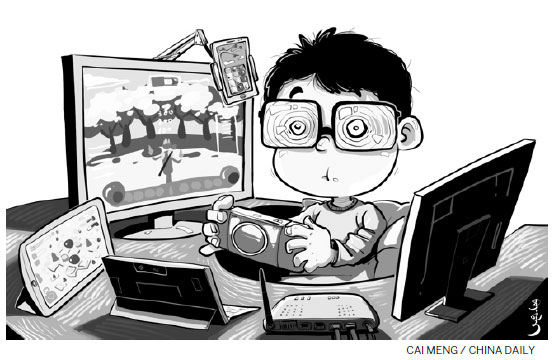
Children and teenagers can get more easily addicted to electronic devices during summer and other vacations and damage their eyesight. Although computers and other electronic devices are being more widely used - particularly by young people - little consideration is paid to the accompanying health risks. This situation has to be changed soon to avoid unnecessary injuries to people using them.
Desktop and laptop computers can cause physical problems, particularly when users are forced to bend their bodies to see the monitors better. Neck or back pain caused by the strain can have serious health consequences. A 2007 study found that chronic neck or back pain was the leading cause of not attending work in the United States. The impact of this finding on economies should not be ignored.
The constant use of desktop computers and laptops, and other electronic devices such as iPads, tablets and smartphones could also alter sleep patterns in ways and to an extent that we haven't realized. A study published in the US Proceedings of the National Academy of Sciences shows people using iPads for four hours or more before bedtime took longer to fall asleep than people who hadn't used them. The negative effects were not limited to iPads, however, because tablets, e-readers, smartphones, laptops and LED monitors with similar blue-light emissions have the same effect.
What makes the situation particularly serious is that loss of sleep could have long-term health implications, such as increasing rates of obesity and diabetes. These negative effects are more frequently seen in students and youngsters, who are more prone to using these devices.
Other health effects of traditional PCs and the new touch-screen devices are motion injuries and eyestrain. Repetitive stress injuries are the result of repetitive movements, which can affect joints, muscles, tendons and nerves possibly with long-term health ramifications. The effects on the eyes, which some ophthalmologists call "computer vision syndrome" include pain, blurred vision and headaches.
People who frequently use their thumbs to type text messages on cellphones can develop a painful affliction called DeQuervain's syndrome that affects the tendons on their hands. The most common disease in this category is called carpal tunnel syndrome, which results from pressure on the median nerve in the wrist.
What makes matters even more complicated is the fact that the children and adolescents now growing up are becoming more used to juggling several interactive devices at the same time. Thus, they may be watching TV while using iPads, smartphones or laptops - and may even be using laptops with hand-held gaming devices. Television in such cases is used oftentimes as background entertainment while they do something else. We have a new generation of youngsters which can no longer imagine a life without these wireless devices, and which seems ignorant of their negative consequences.
Some studies have found that adults who have used cellphones intensively for at least 10 years are more prone to some kind of cancers, such as brain, salivary glands and even some rare eye cancers, than those who didn't use them vigorously. Some initial reports also suggest women have been diagnosed with a rare form of breast cancer in the area of the breast where they kept their cellphones. Although some of these cancers could have occurred by chance, they may also be an early indicator of risk.
Perhaps the best way to avoid some of the negative effects of these devices is to use them in moderation and, when possible, to store them far away from your body. Parents have the responsibility of making their children aware of the dangers these devices pose to their health, and make sure they are used judiciously. Many negative health risks could then be avoided.
The author is an international public health consultant.
(China Daily 07/11/2015 page5)

I’ve lived in China for quite a considerable time including my graduate school years, travelled and worked in a few cities and still choose my destination taking into consideration the density of smog or PM2.5 particulate matter in the region.